Click on images to enlarge
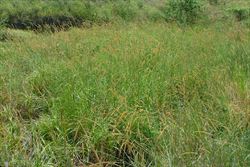
infestation (Photo: Sheldon Navie)
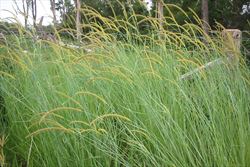
habit (Photo: Sheldon Navie)
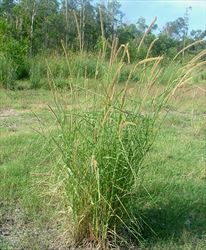
habit (Photo: Sheldon Navie)
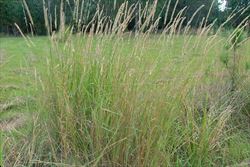
habit in seed (Photo: Sheldon Navie)
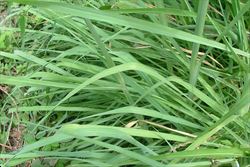
leaves (Photo: Sheldon Navie)
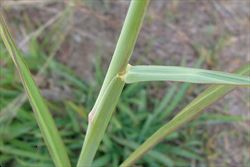
hairless stem, leaf sheath and base of leaf blade (Photo: Sheldon Navie)

close-up of hairy leaf sheaths and base of folded leaf blade (Photo: Sheldon Navie)
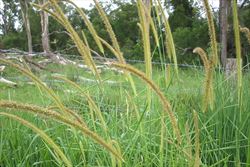
elongated seed-heads (Photo: Sheldon Navie)
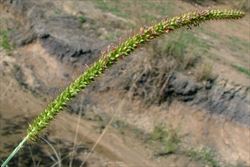
young seed-head in flower (Photo: Sheldon Navie)
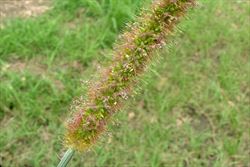
flower spikelets (Photo: Sheldon Navie)
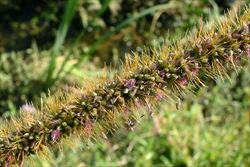
close-up of flower spikelets with golden yellow bristles (Photo: Sheldon Navie)
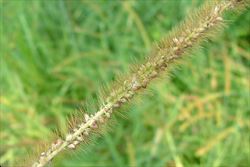
mature seed-head (Photo: Sheldon Navie)
Scientific Name
Setaria sphacelata (Schumach.) Stapf & C.E. Hubb.
Synonyms
Setaria anceps Stapf
Setaria anceps Stapf var. sericea Stapf
Setaria sphacelata (Schumach.) Stapf & C.E. Hubb. var. anceps (Stapf) Veldkamp
Setaria sphacelata (Schumach.) Stapf & C.E. Hubb. var. sericea (Stapf) Clayton
Setaria sphacelata (Schumach.) Stapf & C.E. Hubb. var. splendida (Stapf) Clayton
Setaria splendida Stapf
Family
Gramineae (South Australia)
Poaceae (Queensland, New South Wales, the ACT, Victoria, Tasmania, Western Australia and the Northern Territory)
Common Names
African bristle grass, African bristlegrass, African pigeon grass, canary seed grass, common setaria, golden bristle grass, golden millet, golden setaria, golden Timothy, Kazungula setaria, pigeon grass, pigeongrass, setaria, Rhodesian grass, South African pigeon grass
Origin
Native to tropical and southern Africa (i.e. Cameroon, Zaire, Benin, Burkina Faso, the Ivory Coast, Ghana, Guinea-Bissau, Mali, Mauritania, Nigeria, Senegal, Sierra Leone, Togo, Kenya, Tanzania, Uganda, Angola, Botswana, Namibia, South Africa and Swaziland).
Cultivation
This species is widely grown as a pasture grass in the warmer parts of Australia, particularly in the higher rainfall coastal districts of the sub-tropics. A number of commercial cultivars are available, including 'Nandi', 'Kazungula', 'Narok', 'Solander', and 'Splenda'.
Naturalised Distribution
Widely naturalised in the coastal regions of northern and eastern Australia, and occasionally also found in other regions. It is most widespread and common in eastern Queensland, but is also found in other parts of this state, in north-eastern New South Wales and in the northern parts of the Northern Territory. Occasionally also naturalised in other parts of New South Wales and in the coastal districts of south-western, north-western and northern Western Australia. Possibly also naturalised in Victoria and South Australia.
Naturalised overseas in southern USA (i.e. California, Mississippi, Alabama and Florida), New Zealand and on some Pacific islands (e.g. the Cook Islands and Hawaii).
Habitat
A weed of roadsides, waterways (i.e. riparian areas), grasslands, open woodlands, pastures, parks, disturbed sites and waste areas in the tropical and sub-tropical regions of Australia. Occasionally also found in warmer temperate and semi-arid regions.
Habit
A densely-tufted and long-lived (i.e. perennial) grass often growing up to 2 m tall, and occasionally reaching up to 3 m in height.
Distinguishing Features
- a densely-tufted and long-lived grass often growing up to 2 m tall.
- its green or somewhat bluish-green leaves are elongated in shape (10-50 cm long 3-17 mm wide) and mostly hairless.
- its spike-like seed-heads (7-50 cm long) have densely clustered flower spikelets borne in small groups.
- each group of spikelets is subtended by a ring of 6-15 golden yellow bristles (4-12 mm long).
- when the seeds are shed from the seed-head, the subtending bristles are left behind.
Stems and Leaves
The upright (i.e. erect) flowering stems (i.e. culms) are usually green and hairless (i.e. glabrous).
The green or somewhat bluish-green (i.e. glaucous) leaves consist of a sheath, which encloses the stem, and a spreading leaf blade. The leaf sheaths are smooth and hairless (i.e. glabrous), but where they meet the leaf blade there is a line of hairs (i.e. ciliate ligule) about 1.5 mm long. The elongated (i.e. linear) leaf blades (10- 50 cm long 3-17 mm wide) are soft and mostly hairless (i.e. glabrous) with entire margins and long-pointed tips (i.e. acuminate apices).
Flowers and Fruit
The upright (i.e. erect) seed-heads are spike-like in appearance, but actually consist of numerous very short branches that are held closely to the stem (i.e. they are spiciform panicles). These seed-heads (7-50 cm long and about 8 mm wide) have numerous densely clustered flower spikelets that are borne in small groups of one to four. Each group of spikelets is subtended by a ring (i.e. involucre) of 6-15 golden yellow bristles (4-12 mm long). The individual flowers spikelets (1.25-3.5 mm long) are oval (i.e. elliptic) in shape and consist of a pair of bracts (i.e. glumes) and two tiny flowers (i.e. florets). The lower floret has only male flower parts, while the upper floret has both male and female parts (i.e. it is fertile or bisexual). The fertile florets have three stamens and a purple or white two-branched feathery stigma Flowering occurs mainly during summer.
The 'seed' (i.e. caryopsis or grain) remains contained within the remains of the old flower spikelets. When these 'seeds' are shed from the seed-head, the subtending bristles are left behind.
Reproduction and Dispersal
This species reproduces only by seed.
Seeds are commonly spread through the deliberate cultivation of this species as a pasture grass, and in comtaminated agricultural produce (e.g. fodder). They may also be dispersed by wind, seed-eating (i.e. granivorous) birds and water.
Environmental Impact
South African pigeon grass (Setaria sphacelata) is regarded as an environmental weed in Queensland, New South Wales and Western Australia.
Legislation
Not declared or considered noxious by any state government authorities.
Similar Species
South African pigeon grass (Setaria sphacelata) is similar to yellow bristlegrass (Setaria pumila subsp. pallidefusca) and purple pigeon grass (Setaria incrassata), however these species can be distinguished by the following differences:
- South African pigeon grass (Setaria sphacelata) is a relatively robust long-lived (i.e. perennial) grass often reaching up to 2 m in height. Its narrow seed-heads are very long (7-50 cm long) and its flower spikelets are subtended by clusters of 6-15 golden yellow bristles.
- yellow bristlegrass (Setaria pumila subsp. pallidefusca) is a relatively small short-lived (i.e. annual) grass rarely growing more than 1.3 m in height. Its narrow seed-heads are usually relatively short (1-10 cm long) and its flower spikelets are subtended by clusters of 6-8 golden yellow bristles.
- purple pigeon grass (Setaria incrassata) is a relatively robust long-lived (i.e. perennial) grass occasionally reaching up to 2 m in height. Its narrow seed-heads are relatively long (3-30 cm long) and its flower spikelets are subtended by clusters of 8-10 purple bristles.
South African pigeon grass (Setaria sphacelata) is also similar to some of the foxtail grasses (Pennisetum spp.), including elephant grass (Pennisetum purpureum). However, the 'seeds' of the foxtail grasses (Pennisetum spp.) are shed along with their subtending bristles.

